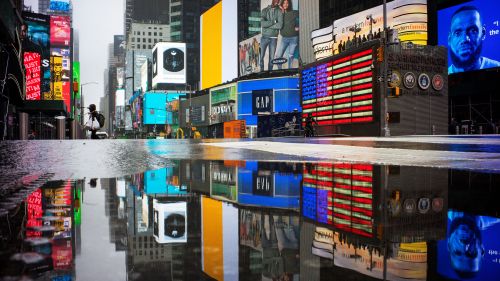Americans Understand the Importance of Social Distancing

In deciding when and how quickly to relax restrictions, leaders should not underestimate the American public’s forbearance for remaining indoors.
Pandemics
The New York Times recently featured a fascinating story about early efforts to implement social distancing as a federal government strategy to combat infectious disease outbreaks. The idea of social distancing, utilized previously during the 1918 Spanish flu outbreak, was proposed anew during the Bush administration to combat a potential pandemic for which no vaccine existed. As noted in the article, President Bush likened the problem of pandemics to forest fires in a speech at The National Institutes of Health in November 2005: "If caught early it might be extinguished with limited damage. If allowed to smolder, undetected, it can grow to an inferno that can spread quickly beyond our ability to control it."
Senior officials at the time dismissed the idea of stay-at-home orders as infeasible. But research going back to 2003 shows that extremely large percentages of Americans have consistently said they would be willing to stay at home to avoid infectious outbreaks.
SARS
In 2002, a virus emerged in southern China also perhaps from bats: Severe Acute Respiratory Syndrome (SARS). The virus eventually affected 26 countries in 2003 with 813 deaths, a mortality rate of 15 percent. Despite SARS’ high mortality rate, COVID-19 has led to a greater number of fatalities and economic repercussions than did SARS because the number of asymptomatic carriers and late-breaking symptoms make it so contagious.
Polling at the time showed that Americans did not greatly fear the spread of SARS, likely reflecting the lower rate of incidence in the United States. The World Health Organization reported only 33 cases between November 2002 and August 2003 in the US, with no deaths. According to Harvard School of Public Health polling at the time, no more than one in ten Americans were concerned that they or someone in their immediate family were likely to contract SARS during the next twelve months (6% in July 2003 and 8% in January 2004).
Despite lower levels of concern and incidence in the United States, Americans were willing to self-quarantine if they had been exposed to someone with the disease (without knowing if they had the disease or not). Ninety-three percent of Americans said they would agree to quarantine themselves or their family for up to ten days if they had been exposed to someone who has SARS.
Avian Flu
The next pandemic to become a global health concern came in 2005 with the H5N1 Avian flu when migratory birds transported the virus most likely from southern China, resulting in a steady rise in human cases (by 2006, 142 cases with 74 deaths). By 2009, the bird flu virus had spread throughout southeastern Asia, and in Eurasia and Africa. Alarmed by the outbreak since there was no vaccine for it, the Bush administration enlisted a team of advisers who began research efforts on social distancing as a way to contain the disease if it spread to the United States.
The bird flu epidemic did not reach the level of a global pandemic, and a January 2006 Harvard School of Public Health survey found that relatively few Americans (21%) were worried that they or someone in their immediate family might get sick from avian flu in next twelve months. Yet, 96 percent said they would agree to stay at home for two to three weeks if they had bird flu and health officials told them to self-quarantine. Eighty-three percent said they would do so if they had been near someone who had bird flu but did not yet show any symptoms.
A study conducted later in 2006 by the Harvard School of Public Health presented a hypothetical scenario about a "possible outbreak in the U.S. of pandemic flu, a new type of flu that spreads rapidly among humans and causes severe illness." Even back then, 94 percent of Americans said they would stay at home away from other people for seven to ten days if they had the pandemic flu; 85 percent said they and all members of their household would stay at home for that period if another member of their household was sick.
The survey also showed that most employed people (74%) believed they could miss seven to ten days of work without having serious financial problems (75% versus 25% who would have problems). A majority (57%) thought they would have serious financial problems if they had to miss work for one month, and a total of three-fourths (76%) think they would have such problems if they were away from work for three months. Only about one-third (35%) of employed Americans thought that if they stayed home from work, they would still get paid. At that time, only 27 percent said they ever worked from home and just 19 percent thought they would be able to work from home for three months; 9 percent thought it would be ok for one month but not three.
Swine Flu
The 2009 swine flu pandemic was caused by a new strain of H1N1 detected first in the United States before spreading to the rest of the world. The World Health Organization declared the swine flu outbreak a pandemic by June of that year. According to the Center for Disease Control (CDC), the virus killed between 151,700 and 575,400 people between the spring of 2009 and the spring of 2010. This statistic includes nearly 12,500 deaths in the United States. May and June 2009 Harvard School of Public Health surveys found that 38 percent of Americans said they were concerned that they or someone in their immediate family might get sick from H1N1 or swine flu during the next twelve months, higher than worry about bird flu or SARS when they were spreading. Nearly all Americans (97%) said they would self-quarantine if they had swine flu and health officials recommended it.
Lessons Learned?
Back in 2006, the principal investigator for one of the Harvard surveys noted that the findings "speak to the resilience of the American public in the face of a potential health crisis." The coronavirus has been more invasive and frightening for Americans than previous epidemics. Both healthy and infected individuals are having to stay at home for longer than some of the time periods asked about in these historical surveys, and many Americans have experienced serious job and income loss.
Even so, polls have shown that except for the minority view expressed by shutdown the shutdown protesters, the public remains tolerant of the shelter-in-place protocols. An April 15-20 Kaiser Family Foundation survey found that 80 percent of Americans say the stay-at-home measures are worth it to protect and limit the spread of the virus. Just 19 percent said they are doing more harm than good. Several other recent surveys echo these findings. In deciding when and how quickly to relax restrictions, community and national leaders should not underestimate the American public’s forbearance for remaining indoors.

